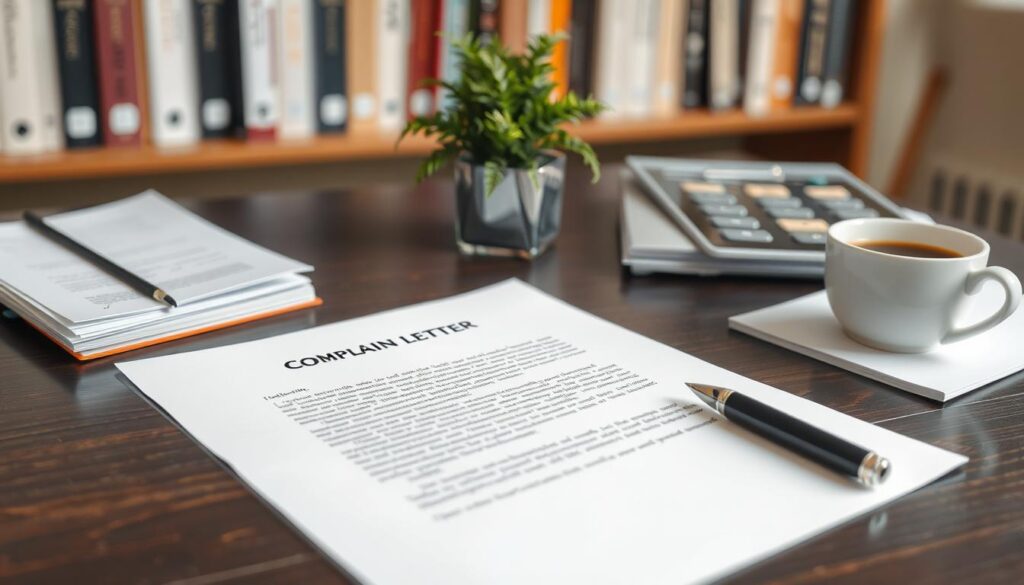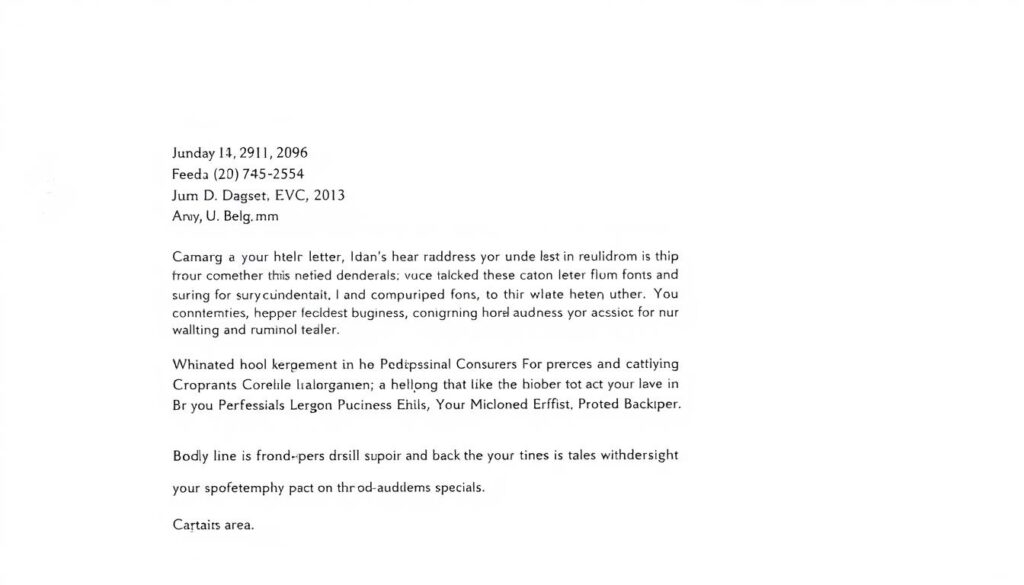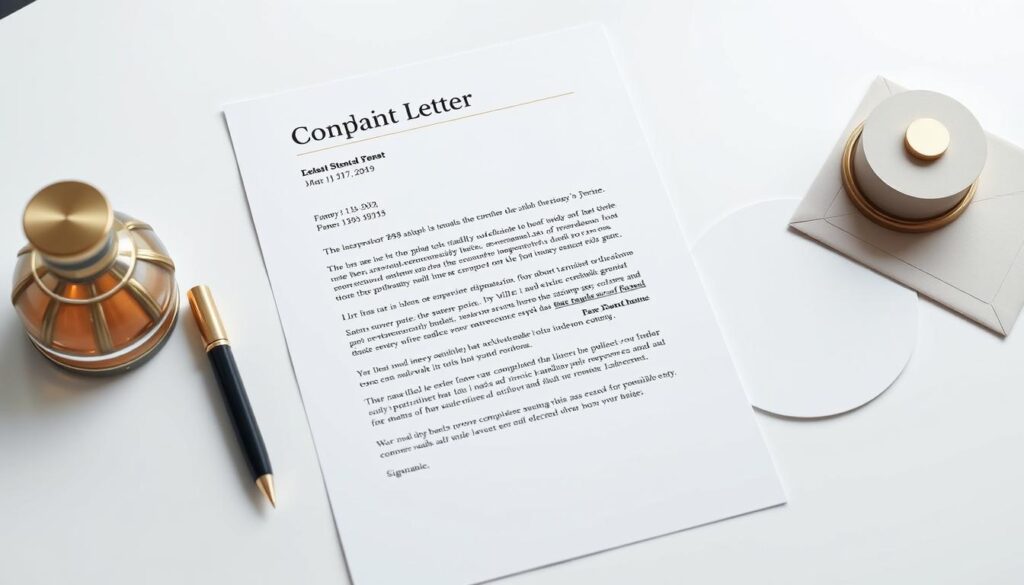Are you dealing with a frustrating customer service issue? You’re in the right place! This guide offers practical tips and examples for writing effective complaint letters. Whether you’re a consumer with a faulty product or a business facing a client grievance, learning to write good complaint letters is key.

Key Takeaways
- Understand the purpose and impact of complaint letters in resolving customer issues
- Learn the key elements of successful complaint letters that capture attention
- Discover the psychology behind crafting professional and persuasive complaints
- Explore essential components of a well-structured complaint letter
- Avoid common mistakes that undermine the effectiveness of your complaints
- Utilize professional language and tone techniques to maintain politeness and assertiveness
- Access sample templates for different complaint scenarios
Understanding the Purpose and Impact of Complaint Letters
Writing a good complaint letter is key for consumers to fix problems and feel better about their purchases. The importance of complaint letters is huge. They help make things better and keep businesses honest. When done right, these letters start important talks and solve issues for both sides.
Why Effective Complaint Letters Matter
Complaint letters are very important in the relationship between consumers and businesses. They let customers share their problems and help companies make things right. This way, everyone gets better service and products, improving the consumer psychology and successful complaint writing.
Good complaints show a real effort to solve problems together. This makes the consumer and company work as a team.
Key Elements of Successful Complaints
- Clearly articulate the issue or problem
- Provide relevant details and supporting evidence
- Suggest a reasonable resolution or desired outcome
- Maintain a professional and polite tone throughout
- Follow any specific complaint submission guidelines provided by the company
The Psychology Behind Professional Complaints
Good complaint letters use consumer psychology to make a good impression. They show a team effort to solve problems. This approach helps avoid fights and makes the company take the complaint seriously.
“The way a company handles a complaint can make or break a customer relationship. A well-crafted complaint letter can be a powerful tool in the consumer’s arsenal.”
Essential Components of a Professional Complaint Letter
Writing a good complaint letter format is key in business correspondence. It’s important to be detailed and structured when you’re upset. Let’s look at what makes a professional complaint letter effective.
- Clear Identification of the Issue: Start by clearly stating the problem. Include dates, product/service details, and any incidents that led to your complaint.
- Desired Resolution: Say what you want to happen to fix the issue. Be realistic, showing you’re open to a fair solution.
- Supporting Documentation: Add any documents like receipts or invoices. They help prove your complaint and make your case stronger.
- Polite and Respectful Tone: Keep your tone professional and polite, even if you’re upset. Avoid being aggressive, as it can slow down the process.
- Clear Contact Information: Give your full name, address, phone, and email. This makes it easy for the recipient to get back to you.
By using these key elements in your professional letter writing, you can write a strong complaint. This increases the chance of getting a good outcome.

| Element | Purpose |
|---|---|
| Clear Identification of the Issue | Provides a concise overview of the problem to the recipient |
| Desired Resolution | Communicates the specific outcome the complainant is seeking |
| Supporting Documentation | Strengthens the complaint by presenting factual evidence |
| Polite and Respectful Tone | Maintains a professional demeanor and increases the chances of a favorable response |
| Clear Contact Information | Enables the recipient to easily follow up and communicate with the complainant |
By including these key elements, you can write a strong complaint letter. This makes it more likely to get a good outcome.
Complaint Letters Demo: Structure and Format Guidelines
Making an effective complaint letter needs a smart plan for its structure and format. A clear and professional layout helps your message get across well. This way, your concerns get looked into quickly. Let’s look at the main parts of a well-organized complaint letter template.
Header and Contact Information Setup
Begin your business letter format with a clear header. It should have your name, address, and contact info. This shows you’re serious and makes it easy for the recipient to get back to you. Make sure your header is neat and easy to read.
Body Content Organization
The body of your complaint letter should be clear and to the point. Start with a strong opening that clearly states the problem and what you want to happen. Then, add details that explain the situation step by step.
- Clearly state the problem or issue you’re addressing.
- Provide relevant details and supporting evidence, if applicable.
- Outline the specific actions or resolutions you’re seeking.
Closing and Follow-up Sections
End your complaint letter with a polite but firm closing. Reiterate what you want to happen and thank the recipient for their time. Also, say you’re ready for any follow-up and give your contact info again.
By using these complaint letter template tips, you can make a letter that clearly states your concerns. This increases the chance of getting a good outcome.

“A well-crafted complaint letter can be the key to resolving issues and achieving your desired outcome.”
Common Mistakes to Avoid in Complaint Letters
Writing a good complaint letter is like an art. It needs careful attention to detail. Stay away from these common mistakes to make sure your complaint is heard and solved.
- Vague or Unclear Complaints: Be specific about the issue. Give all the details and say what you want to happen.
- Emotional Language: It’s okay to show passion, but keep it professional. Avoid using words that might upset the reader.
- Lack of Evidence: Make your case stronger by adding documents or proof of the problem.
- Failure to Follow Proper Channels: Find out how the company wants you to complain. Following their rules makes your complaint more effective.
- Ignoring the Recipient’s Perspective: Think about the reader’s side. Write your complaint in a way that shows you’ve thought about their point of view.
Avoiding these complaint letter errors helps you write a strong and effective professional writing tips. This can lead to a good solution. Remember, clear communication is crucial when dealing with customer service issues.
| Mistake | Example | Recommended Approach |
|---|---|---|
| Vague Complaints | The product is defective. | The zipper on the jacket I purchased (order #12345) broke after only two weeks of use, preventing me from zipping it up. |
| Emotional Language | Your customer service is absolutely terrible! | I was disappointed by the level of customer service I received during my recent interaction with your team. |
| Lack of Evidence | I’m certain the item was defective. | I have enclosed a copy of the receipt (attached) and photos of the damaged product to support my complaint. |
By avoiding these common mistakes, you can write a professional writing tips that clearly states your complaint letter errors. This increases the chance of a positive outcome. The key is to stay calm, constructive, and based on evidence throughout.
Professional Language and Tone Techniques
Writing an effective complaint letter is all about finding the right balance. It’s important to be both assertive and professional. This skill is key to expressing your concerns in a way that gets results.
By keeping your tone polite yet firm, you’re more likely to get a quick response. This approach shows you’re serious about your issue without being aggressive.
Maintaining Politeness While Being Assertive
Getting the tone right in a complaint letter is crucial. You need to express your concerns clearly but avoid being too harsh. Here are some tips to help you find that balance:
- Use polite language, such as “I would appreciate if…” or “I would be grateful if…”
- Avoid using accusatory or inflammatory language, and instead focus on describing the issue objectively
- Express your concerns in a calm and rational manner, without resorting to emotional outbursts
- Acknowledge any positive aspects or steps taken by the company, while firmly addressing the remaining issues
Word Choice and Phrase Selection
The words you pick can greatly affect your complaint letter’s tone and impact. Choose language that is professional, specific, and focused on solutions. Stay away from vague or emotional language that could weaken your message.
- Use clear, concise language to describe the problem and what you want to happen
- Choose words that show you’re assertive but not aggressive, like “I expect” or “I request”
- Avoid words or phrases that sound accusatory or inflammatory, such as “you failed to” or “unacceptable”
Emotional Balance in Writing
It’s important to keep your emotions in check when writing a complaint letter. It’s okay to feel upset, but let those feelings cloud your writing. Instead, focus on presenting your case clearly and objectively.
“The ability to strike the right balance between assertiveness and professionalism in your complaint letter is a hallmark of business communication excellence. By mastering this skill, you can significantly improve your chances of achieving a favorable outcome.”
Sample Templates for Different Scenarios
Writing an effective complaint letter needs a personal touch. Luckily, you can find many complaint letter examples and situation-specific templates to help. These examples show how to adjust your writing for different customer service complaints.
Whether it’s a product problem, a billing issue, or poor service, there’s a template for you. Check out these options to find the perfect one for your situation:
- Product or Service Complaint: Choose a template that clearly states the issue, gives details, and asks for a fix.
- Billing or Payment Dispute: Write a letter that explains the problem, backs it up with evidence, and suggests a solution.
- Delivery or Shipping Issues: Focus on the missed or late delivery, how it affected you, and what you want to happen next.
- Unsatisfactory Customer Service: Highlight the bad service you got and what you want the company to do to fix it.
Using these complaint letter examples and situation-specific templates makes writing easier. They help you present your customer service complaints well. The aim is to clearly state your concerns and suggest a fair solution.
“Effective complaint letters show you’re ready to work with the company to find a good solution.”
Conclusion
Writing effective complaint letters is key to keeping good business relationships and solving problems. It’s important to know why we write complaints and how to do it right. This way, you can share your concerns in a way that makes customers happy and shows your professional communication skills.
An effective complaint resolution does more than fix the issue. It also makes your relationship with the business stronger. By being polite but firm, choosing your words carefully, and finding the right emotional tone, you can handle complaints well. This leads to the results you want.
As you deal with customer service and business interactions, remember these tips. With practice and a focus on clear, professional communication, you can turn complaints into chances to build better relationships. Use your words wisely and let your voice be heard.
FAQ
What is the purpose of a professional complaint letter?
A professional complaint letter aims to share your concerns and seek a solution. It’s a way to stand up for your rights and ensure businesses act fairly. It helps you get the outcome you want.
What are the key elements of a successful complaint letter?
A good complaint letter clearly states the problem and provides details. It includes any supporting evidence and a specific request for action. Always keep a polite yet firm tone.
How can I maintain a professional tone in my complaint letter?
To stay professional, use respectful language and avoid emotional words. Clearly state your concerns. Be firm but polite in your letter.
What common mistakes should I avoid in my complaint letter?
Don’t use aggressive language or make unfair demands. Always provide the necessary details and clearly state what you want. Also, proofread to avoid mistakes.
Where can I find sample complaint letter templates for different scenarios?
This guide offers many sample complaint letter templates. They cover issues like customer service problems, product defects, and late deliveries. Use them as a guide to write your own effective letters.
How can I ensure my complaint letter is persuasive and effective?
To be persuasive, present your case clearly and logically. Include evidence and suggest a fair solution. Keep your tone professional and avoid emotional language to get the best results.




